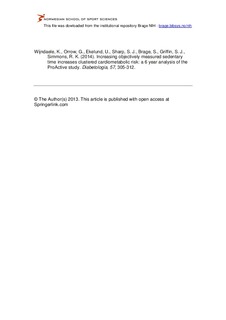| dc.contributor.author | Wijndaele, Katrien | |
| dc.contributor.author | Orrow, Gillian | |
| dc.contributor.author | Ekelund, Ulf | |
| dc.contributor.author | Sharp, Stephen J. | |
| dc.contributor.author | Brage, Søren | |
| dc.contributor.author | Griffin, Simon J. | |
| dc.contributor.author | Simmons, Rebecca K. | |
| dc.date.accessioned | 2014-11-13T14:18:35Z | |
| dc.date.available | 2014-11-13T14:18:35Z | |
| dc.date.issued | 2013-11-06 | |
| dc.identifier.citation | Diabetologia. 2014, 57, 305-312 | nb_NO |
| dc.identifier.uri | http://hdl.handle.net/11250/225886 | |
| dc.description | © The Author(s) 2013. This article is published with open access at Springerlink.com | nb_NO |
| dc.description.abstract | Aims/hypothesis: We aimed to quantify the associations between change in objectively measured sedentary and moderate-to-vigorous physical activity (MVPA) times and self-reported television viewing over 6 years and change in a clustered cardiometabolic risk score (CCMR), including and excluding waist circumference (CCMR without adiposity component, CCMR no adip ), and its individual components, among the adult children of people with type 2 diabetes.
Methods: In 171 adults (mean ± SD age 42.52 ± 6.30 years; 46% men) with a parental history of diabetes (ProActive UK), physical activity accelerometer measures and self-reported television viewing were assessed at baseline and a mean ± SD of 6.27 ± 0.46 years later. Associations between change in sedentary time, MVPA time and television viewing and cardiometabolic risk and mediation by adiposity change were examined by multiple linear regression and the product of coefficients method, respectively.
Results: Greater increases in sedentary time (h/day) were associated with larger increases in clustered cardiometabolic risk (CCMR: 0.08 [95% CI 0.01, 0.15]; CCMR no adip : 0.08 [0.01, 0.16]) and triacylglycerol (0.15 [0.01, 0.29]), independent of baseline sedentary and MVPA times, change in MVPA time and other confounders. No evidence was found for mediation by change in waist circumference and BMI for the associations with CCMR no adip and triacylglycerol. Greater increases in MVPA time (h/day) were associated with larger decreases in waist circumference (−3.86 [−7.58, −0.14]), independently of baseline MVPA and sedentary times, change in sedentary time and other confounders. Television viewing was not independently associated with any of the cardiometabolic outcomes.
Conclusions/interpretation: Increasing sedentary time is independently related to increasing clustered cardiometabolic risk and triacylglycerol in adults at high risk of developing diabetes. Strategies to prevent diabetes might target reducing sedentary time. | nb_NO |
| dc.language.iso | eng | nb_NO |
| dc.publisher | Springer Verlag | nb_NO |
| dc.subject | adiposity | nb_NO |
| dc.subject | cardiovascular disease risk | nb_NO |
| dc.subject | longitudinal study | nb_NO |
| dc.subject | moderate-to-vigorous physical activity | nb_NO |
| dc.subject | sedentary behaviour | nb_NO |
| dc.subject | television viewing | nb_NO |
| dc.title | Increasing objectively measured sedentary time increases clustered cardiometabolic risk: a 6 year analysis of the ProActive study | nb_NO |
| dc.type | Journal article | nb_NO |
| dc.type | Peer reviewed | nb_NO |
| dc.subject.nsi | VDP::Medical disciplines: 700 | nb_NO |
| dc.source.journal | Diabetologia | nb_NO |
| dc.description.localcode | Seksjon for idrettsmedisinske fag / Department of Sports Medicine | nb_NO |
